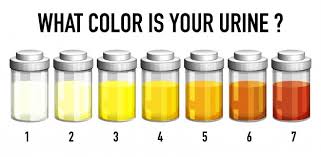
Urine colors can change depending on what you eat, whatever medications you’re taking, and how much water you drink. Many of these colors are within the range of what “normal” urine can be, however there are some circumstances where uncommon urine colors should be taken seriously.
Clear urine color
If your urine is clear, you’re consuming more water than the daily suggested quantity.
While being hydrated is important, too much water can deplete your body’s electrolytes. Urine that seems clear on occasion isn’t cause for concern, but urine that appears clear all of the time may signal that you need to reduce your water intake.
Cirrhosis and viral hepatitis are two conditions that might cause clear urine. If you’re not drinking enough water and your pee is consistently clear, you should consult a doctor.
Yellowish to amber color
The color of “normal” urine ranges from light yellow to a darker amber tone. As you drink more water, the urochrome pigment in your urine becomes more diluted.
When your body breaks down hemoglobin, the protein that transports oxygen in your red blood cells, urochrome is created. The color of your urine will, in most cases, be determined by how diluted this pigment is.
Urine can turn neon yellow if you have a lot of B vitamins in your bloodstream.
Red or pink
Beets can turn it reddish or pinkish, carrots can turn it orange, and some TB drugs can turn it from orange to pinkish. However, if your pee changes color unexpectedly and you’re not sure why, consult your doctor.
While crimson or pink urine could be the result of something you ate recently, there are other possibilities. Blood can occur in your urine as a symptom of certain health disorders, which is known as hematuria:
-Prostate enlargement
-Stones in the kidneys
-Bladder and kidney tumors are two types of tumors that can occur in the body.
Orange
It could be a sign of dehydration if your urine turns orange. If you have orange urine and light-colored feces, bile may be entering your circulation as a result of problems with your bile ducts or liver. Orange urine is another symptom of adult-onset jaundice.
Blue Green
Food coloring can induce blue or green urine. It could also be caused by dyes used in medical examinations on your kidneys and bladder.
Your urine may color blue, green, or even indigo purple if you have a pseudomonas aeruginosa bacterial infection. In general, blue urine is uncommon and is most likely caused by something you eat.
Dark brown
Dehydration is usually indicated by dark brown urine. Certain drugs, such as metronidazole (Flagyl) and chloroquine, can cause dark brown urine as a side effect (Aralen).
Dark brown urine can be caused by eating a much of rhubarb, aloe, or fava beans. Porphyria is a disorder that causes a buildup of natural chemicals in your bloodstream, resulting in rusty or dark urine. Because bile can seep into your urine, dark brown urine can potentially be a symptom of liver illness.
Summary
Maintaining a healthy bladder requires drinking plenty of water. People should, however, keep track of how much water they consume.
You should be able to tell how many glasses you need based on the color of your pee. “Environmental issues should also be taken into account,” he added.
He explained that hot or humid weather can cause one to sweat, necessitating greater fluid consumption. High heights can also cause dehydration.
According to a study, you require more water even in cold regions because your body is forced to warm and humidify the cold, dry air you inhale every time you breathe.
Then, with each breath, you lose a large amount of water, which helps you maintain your body temperature and minimizes the risk of hypothermia.
He suggested, “Drink enough water to hydrate the body, but not more than the body requires.”

Recent Comments